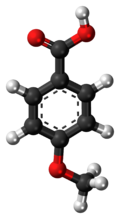p-Anisic acid
| |||
| Names | |||
|---|---|---|---|
| IUPAC name
4-Methoxybenzoic acid
| |||
| Other names
Draconic acid
| |||
| Identifiers | |||
3D model (JSmol)
|
|||
| ChEBI | |||
| ChEMBL | |||
| ChemSpider | |||
| ECHA InfoCard | 100.002.562 | ||
PubChem CID
|
|||
| UNII | |||
CompTox Dashboard (EPA)
|
|||
| |||
| Properties | |||
| C8H8O3 | |||
| Molar mass | 152.149 g·mol−1 | ||
| Density | 1.385 g/cm3 | ||
| Melting point | 184 °C (363 °F; 457 K) (sublimation) | ||
| Boiling point | 275 to 280 °C (527 to 536 °F; 548 to 553 K) | ||
| 1 part per 2500 | |||
| Structure[2] | |||
| monoclinic | |||
| P21/a | |||
a = 16.98 Å, b = 10.95 Å, c = 3.98 Å α = 90°, β = 98.7°, γ = 90°
| |||
Formula units (Z)
|
4 | ||
Except where otherwise noted, data are given for materials in their standard state (at 25 °C [77 °F], 100 kPa).
| |||
p-Anisic acid, also known as 4-methoxybenzoic acid or draconic acid, is one of the isomers of anisic acid. The term "anisic acid" often refers to this form specifically. It is a white crystalline solid which is insoluble in water, highly soluble in alcohols and soluble in ether, and ethyl acetate.
Synthesis and occurrence
p-Anisic acid is found naturally in anise. It is generally obtained by the oxidation of anethole or p-methoxyacetophenone.
Uses
p-Anisic acid has antiseptic properties. It is also used as an intermediate in the preparation of more complex organic compounds.
References
- ^ Merck Index, 11th Edition, 696
- ^ Bryan, Robert F. (1967). "An X-ray study of the p-n-alkoxybenzoic acids. Part II. The crystal structure of anisic acid". Journal of the Chemical Society B: Physical Organic: 1311. doi:10.1039/j29670001311. ISSN 0045-6470.


